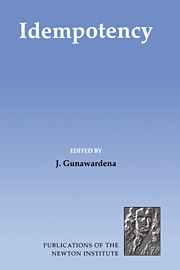Book contents
- Frontmatter
- Contents
- Foreword
- Preface
- List of Participants
- An introduction to idempotency
- Tropical semirings
- Some automata-theoretic aspects of min-max-plus semirings
- The finite power property for rational sets of a free group
- The topological approach to the limitedness problem on distance automata
- Types and dynamics in partially additive categories
- Task resource models and (max, +) automata
- Algebraic system analysis of timed Petri nets
- Ergodic theorems for stochastic operators and discrete event networks.
- Computational issues in recursive stochastic systems
- Periodic points of nonexpansive maps
- A system-theoretic approach for discrete-event control of manufacturing systems
- Idempotent structures in the supervisory control of discrete event systems
- Maxpolynomials and discrete-event dynamic systems
- The Stochastic HJB equation and WKB method
- The Lagrange problem from the point of view of idempotent analysis
- A new differential equation for the dynamics of the Pareto sets
- Duality between probability and optimization
- Maslov optimization theory: topological aspect
- Random particle methods in (max, +) optimization problems
- The geometry of finite dimensional pseudomodules
- A general linear max-plus solution technique
- Axiomatics of thermodynamics and idempotent analysis
- The correspondence principle for idempotent calculus and some computer applications
Duality between probability and optimization
Published online by Cambridge University Press: 05 May 2010
- Frontmatter
- Contents
- Foreword
- Preface
- List of Participants
- An introduction to idempotency
- Tropical semirings
- Some automata-theoretic aspects of min-max-plus semirings
- The finite power property for rational sets of a free group
- The topological approach to the limitedness problem on distance automata
- Types and dynamics in partially additive categories
- Task resource models and (max, +) automata
- Algebraic system analysis of timed Petri nets
- Ergodic theorems for stochastic operators and discrete event networks.
- Computational issues in recursive stochastic systems
- Periodic points of nonexpansive maps
- A system-theoretic approach for discrete-event control of manufacturing systems
- Idempotent structures in the supervisory control of discrete event systems
- Maxpolynomials and discrete-event dynamic systems
- The Stochastic HJB equation and WKB method
- The Lagrange problem from the point of view of idempotent analysis
- A new differential equation for the dynamics of the Pareto sets
- Duality between probability and optimization
- Maslov optimization theory: topological aspect
- Random particle methods in (max, +) optimization problems
- The geometry of finite dimensional pseudomodules
- A general linear max-plus solution technique
- Axiomatics of thermodynamics and idempotent analysis
- The correspondence principle for idempotent calculus and some computer applications
Summary
Introduction
Following the theory of idempotent Maslov measures, a formalism analogous to probability calculus is obtained for optimization by replacing the classical structure of real numbers (ℝ, +, ×) by the idempotent semifield obtained by endowing the set ℝ ∪ {+∞} with the “min” and “+” operations. To the probability of an event corresponds the cost of a set of decisions. To random variables correspond decision variables.
Weak convergence, tightness and limit theorems of probability have an optimization counterpart which is useful for approximating the Hamilton–;Jacobi–Bellman (HJB) equation and obtaining asymptotics for this equation. The introduction of tightness for cost measures and its consequences is the main contribution of this paper. A link is established between weak convergence and the epigraph convergence used in convex analysis.
The Cramér transform used in the large deviation literature is defined as the composition of the Laplace transform by the logarithm by the Fenchel transform. It transforms convolution into inf-convolution. Probabilistic results about processes with independent increments are then transformed into similar results on dynamic programming equations. The Cramér transform gives new insight into the Hopf method used to compute explicit solutions of some HJB equations. It also explains the limit theorems obtained directly as the image of the classic limit theorems of probability.
Cost Measures and Decision Variables
Let us denote by ℝmin the idempotent semifield (ℝ ∪ {+∞}, min, +) and by extension the metric space ℝ ∪ {+∞} endowed with the exponential distance d(x, y) = I exp(–x) – exp(–y).
- Type
- Chapter
- Information
- Idempotency , pp. 331 - 353Publisher: Cambridge University PressPrint publication year: 1998
- 12
- Cited by



